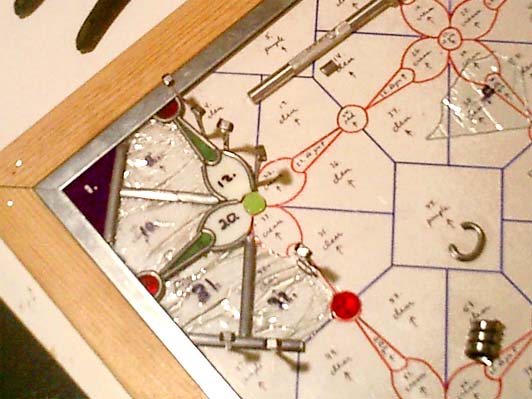 |
 |
 |
|
I'm learning the art (or is it a craft?) of stained glass. At this weblog, I record progress, note useful links, and document flesh wounds. Links
The Art League
Weisser Glass Studio
Virginia Stained Glass Co.
Warner-Crivellaro
Glass Galleries Links List
The StoreFinder: Stained Glass Store Front
ArtGlassArt.com Tutorials
rec.crafts.glass
Nancy's Beginner Tips and Tricks
Splinter Removal Tips
Syndicate this site
Archives
By Date
November 2006 October 2006 May 2006 June 2004 October 2003 September 2003 August 2003 June 2003 May 2003 April 2003 March 2003 February 2003 January 2003 December 2002 November 2002 October 2002 September 2002 By Project Beaded Unity Candle Crocus Panel Dogwood Windows Green Tiered Lamp Lilypads/Lotus Panel Transoms Xmas Ornament |
 |
November 25, 2006: Anal-Retentives Apply Within
A couple of days ago, I began the process of faux-laminating my cutting pattern with Mylar and spray adhesive, and then the actual cutting. It's tedious work, not to mention sticky, and I didn't get too far before telling myself that I really needed to know that the laminated and cut pieces would hold up on the grinder before going so far as to cut out all 230-odd pieces. So I located the first couple of pattern pieces according to building order, and cut some glass accordingly. Indeed there were a couple small process kinks to work out there, having to do with the need to spray pattern pieces and glass, then let them sit for a couple of minutes to partially air-dry before putting the two together, for maximum stickiness. With previous projects my pattern pieces have been just plain paper, affixed with glue sticks, but the combination of glue stick and Mylar just makes a slippery mess that slides around all over the place on the grinder. And actually, about the same thing happens if you try to slap together a Mylar-ed pattern piece and some glass immediately after applying the spray adhesive. So I got that all worked out, and thought about laminating and cutting the rest of my pattern. And then I told myself that I really needed to know that the repeating design motif of my pattern was truly buildable in lead---it is, as I have mentioned before, of a sufficiently small and picky scale that copper foil would for most people probably be the more natural choice here. And so I began leading.
If it all sounds like I may be experiencing a certain amount of impatience with regards to laminating and cutting my pattern, there might just be something to that. That's not the fun stuff. Leading is. Still, it's not all excuses and rationalizations here. There's definitely a bit of a learning curve going on as I fight my way through the leading of my first dogwood shape, especially since I'm working in lead with only a 1/8" face width around the flower: that leaves almost zero wiggle room for hiding mistakes. I'll want to lead in one of each of my problematic little circles (the light green dogwood centers and the red faceted jewels) before I consider myself to have walked through a successful and complete proof-of-concept, but it got late, and I have no idea how well the noise of my glass grinder may carry. Our neighbors live frightfully close; I may have mentioned before how I am sometimes awakened early in the morning by the sound of the neighbor lady sweet-talking her mildly neurotic Labrador retriever. Must address the camera situation soon. While doing a bit of web research to try to be able to quantify in precise technical terminology what I love about the big old broken camera and what I hate about the tiny less-old working camera, I discovered that the T.L.-O.W.C. has what's called a "fixed focus" lens, which is supposed to be result in more-or-less in-focus photos "from one meter to infinity." Aaaaand, there's my problem. For purposes of this here little weblog, having to take photos from a meter away is pretty much unacceptable. So whenever I break down and begin shopping for a new camera (ideally with a large pile of cash dropped by the gods from the sky for that exact purpose?), I will know to avoid that. It's a shame, though, in a way---I also learned that the fixed focus is a big part of why the little camera (Casio Exilim, second-generation) is so beautifully fast. The camera ex machina, thus, will necessarily have to be a slow(er) one. It's a lot like the primary rule of reasonable expectations that is much quoted by web developers and probably folks in many, many other professions: of Good, Fast, and Cheap, a client/consumer may ask for, and in fact receive, precisely two. Posted by Michelle on November 25, 2006 10:55 PM Comments
Post a comment
|
| Copyright © 2002-06 Michelle Kinsey Bruns. E-mail me at my first name at this domain. (Take that, spam spiders!)
|
||
